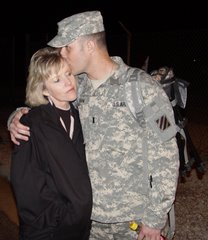A little late posting this but too important to pass up. These guys just keep doing outstanding work! Awesome job guys!
Army Sgt. 1st Class Max Donahue (right), Lt. Col. John Kolasheski (middle) and an interpreter survey a ditch where Donahue's platoon found several explosively formed penetrators on Sunday.
 Michael Gisick / S&S Staff Sgt.
Michael Gisick / S&S Staff Sgt. Daniel Butler, front, Spc. Tim O’Donnell, left, and Spc. Tim Davis process a cache of explosively formed penetrators discovered in a village southeast of Baghdad on Sunday. The soldiers are members of the 789th Explosive Ordnance Disposal Company. Officers believe the cache belonged to an alleged Shiite militant who was arrested two weeks ago.
Tip leads platoon to EFP, weapons caches
Officials say stashes may be linked to man who led U.S.-backed militia
By Michael Gisick, Stars and Stripes
Mideast edition, Tuesday, February 12, 2008
TUWAITHA, Iraq — A U.S. Army platoon southeast of Baghdad discovered two caches of explosively formed penetrators and other weapons this weekend that commanders say they may be able to tie directly to Iran.
The caches, discovered Friday and Sunday near the village of Jurf al-Nadaf, also may have ties to a man who until recently led a group of U.S.–backed neighborhood militia, officers said.
Officers believe the cache belonged to an alleged Shiite militant who was arrested two weeks ago.
They say the man, whom they declined to name, is believed to have led a cell of 10 to 12 militants and may have travelled to Iran for training.
The man’s brother, described as the midlevel leader of a probationary “Sons of Iraq” group, as the military calls them, fled after the man’s arrest and is also wanted by U.S. troops, said Capt. Ernie Melton, 32, of San Antonio, commander of Troop C, 3rd Squadron, 1st Cavalry Regiment. Melton’s troops found the cache.
The cache found Friday consisted of 13 EFPs, 37 blocks of C4 explosive, a mortar tube and a rocket-propelled grenade launcher. Officers said it was easily the largest EFP cache found in the area.
On Sunday, the platoon found five more EFPs, several shaped charges, 28 grenades, three RPG rounds and detonating devices hidden in the weeds of an abandoned field approximately 650 feet from the building where the earlier cache was found.
EFPs, which are explosive charges that essentially hurl a slug of molten metal, have become perhaps the most widely feared weapon used against U.S. troops because of their ability to penetrate armor.
Senior American officials have long claimed that Iran is supplying and training Shiite militants with the relatively sophisticated devices.
Officers here say they may have evidence that goes beyond that general assumption.
“Our [explosive ordnance disposal] specialists believe it’s Iranian C4” based on the lot numbers, said Army Lt. Col. John Kolasheski, commander of the Fort Benning, Ga.-based 3-1 Cav.
The EFPs and other weapons are being tested for fingerprints and other evidence, Kolasheski said.
Members of Troop C’s 3rd Platoon, which found the weapons, said they were led to them by members of a neighborhood militia group.
“The report we got was one [improvised explosive device],” said Sgt. 1st Class Max Donahue, 39, of Houston. Donahue said his patrol proceeded to a building described by the neighborhood militia members, where they found the EFPs inside a bag.
“As soon as I cut it open, I realized what we were really looking at,” he said.
Summing up the universal respect accorded to the weapon, Donahue said “they would have destroyed us if we’d hit them on a patrol. It would have been catastrophic death.”
Donahue said the second find was made after a man reported a machine gun hidden in a building next to the field.






No comments:
Post a Comment